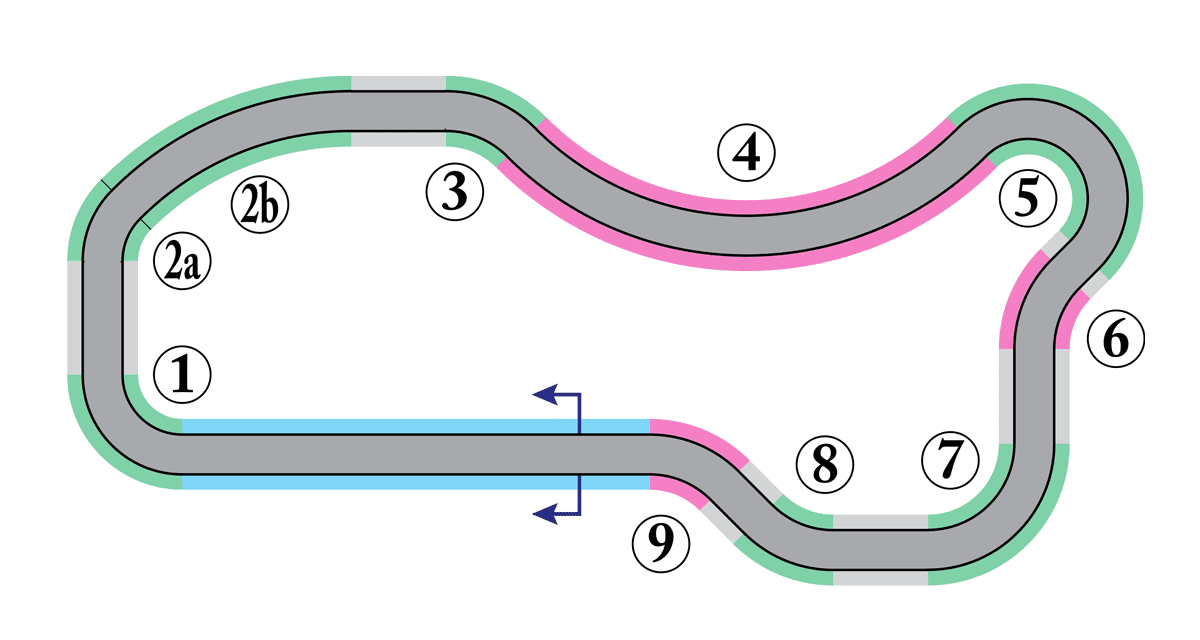 Writing last September’s profile of motorcycle flat track racing renewed my long-dormant interest in TT racing, in which the typical oval track is tweaked into a sort of kidney shape that features at least one turn in each direction and a jump, but that opposite turn is typically rather subtle, almost vestigial. That got me thinking about track design; how much “enhancement” would a basic oval track need to provide real right and left turns? At first I considered something very close to the traditional dirt oval, scaling down one end of the oval and reversing it within the outer track, with 180-degree curves between the inner and outer half-ovals, creating a simple “C” shape. But there was one big problem: no runoff areas. On the inner track, bikes and riders sliding toward the outside of the turn could either slam into a wall or slide into the traffic on the opposite end of the course. I began to ask: how I could incorporate the whole gamut of turns — right and left, increasing and decreasing radii, wide sweepers, chicanes and tight hairpins — within a minimal length (1/2 mile or so) and the fewest number of turns? I wanted a “teaching track,” with well-defined, predictable turns that would be easy for student drivers to classify and study. That question blossomed over several months into a full-fledged circuit design exercise. I can’t be the only one here who has attempted to sketch out his dream circuit. The first design I sketched out was still not too far removed from a basic oval. I was quite happy with it until I identified a requirement I hadn’t considered: the aerial view of my dream circuit couldn’t look like a geoglyph of male genitalia. So it was back to the drawing board. I tweaked that design, while also deciding that it should be properly paved, not dirt, so I could run karts on it.
Writing last September’s profile of motorcycle flat track racing renewed my long-dormant interest in TT racing, in which the typical oval track is tweaked into a sort of kidney shape that features at least one turn in each direction and a jump, but that opposite turn is typically rather subtle, almost vestigial. That got me thinking about track design; how much “enhancement” would a basic oval track need to provide real right and left turns? At first I considered something very close to the traditional dirt oval, scaling down one end of the oval and reversing it within the outer track, with 180-degree curves between the inner and outer half-ovals, creating a simple “C” shape. But there was one big problem: no runoff areas. On the inner track, bikes and riders sliding toward the outside of the turn could either slam into a wall or slide into the traffic on the opposite end of the course. I began to ask: how I could incorporate the whole gamut of turns — right and left, increasing and decreasing radii, wide sweepers, chicanes and tight hairpins — within a minimal length (1/2 mile or so) and the fewest number of turns? I wanted a “teaching track,” with well-defined, predictable turns that would be easy for student drivers to classify and study. That question blossomed over several months into a full-fledged circuit design exercise. I can’t be the only one here who has attempted to sketch out his dream circuit. The first design I sketched out was still not too far removed from a basic oval. I was quite happy with it until I identified a requirement I hadn’t considered: the aerial view of my dream circuit couldn’t look like a geoglyph of male genitalia. So it was back to the drawing board. I tweaked that design, while also deciding that it should be properly paved, not dirt, so I could run karts on it. 
What Would Your Fantasy Track Look Like?

